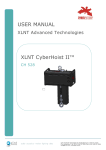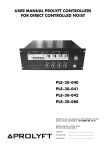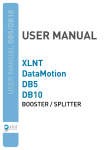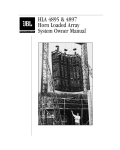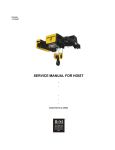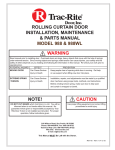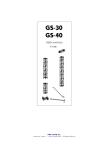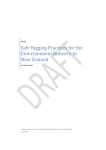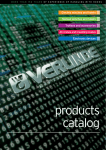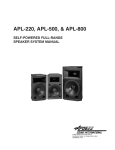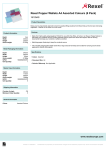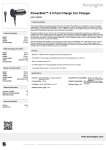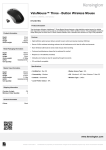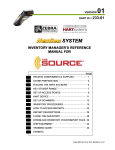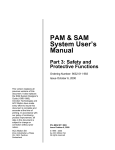Download USER MANUAL - XLNT: advanced technologies
Transcript
USER MANUAL CyberHoist USER MANUAL XLNT Advanced Technologies - CyberHoist CH 1000/500/250 EU/US Version 3 - 22 Januari 2009 1 Declaration of Conformity Manufacturer’s name: XLNT Advanced Technologies Manufacturing BV Address: Proostwetering 50 3543 AH Utrecht The Netherlands USER MANUAL CyberHoist Declares that the products: Name: CH-1000 EU CH-500 EU CH-250 EU CH-1000 US CH-500 US CH-250 US Conform to the following EC Directives and (international) standards: 2006/42/EC - Machinery Directive 2006/95/EC Low Voltage Directive 89/336/EEC “EMC” Directive EN-ISO 13849-1:2006 Safety of machinery - Safety-related parts of control systems - Part 1: General principles for design EN 60204-32 Safety of machinery – Electrical equipment of machines – Part 32: Requirements for hoisting machines EN 55022:2006/A1:2007 Information technology equipment - Radio disturbance characteristics - Limits and methods of measurement EN 61000-3-2 (2000) Electromagnetic compatibility (EMC) - Part 3-2: Limits - Limits for harmonic current emissions (equipment input current 16 A per phase) EN-IEC 61000-3-2:2006 Electromagnetic compatibility (EMC) - Part 3-2: Limits - Limits for harmonic current emissions (equipment input current 16 A per phase) EN-IEC 61000-3-3:1995/A1:2001/IS1:2005 Electromagnetic compatibility (EMC) - Part 3-3: Limitation of voltage changes, voltage fluctuations and flicker in public low-voltage supply systems, for equipment with rated current 16 A per phase and not subject to conditional connection EN 55024:1999/A1:2002, EN 55024:1999/A2:2003 Information technology equipment - Immunity characteristics - Limits and methods of measurement EN ISO 12100 1 & 2 - Safety of Machinery EN 818 - Chain Quality, choice criteria and technical requirements DIN 15400 & 15401 - Lifting hooks for Hoists DIN 56950 - Entertainment Industry: Machinery installations - Safety requirements and testing FEM 9.511 - Classification of the mechanisms FEM 9.661 - Dimensions and Quality of the drive and cable lifting block elements for mass-produced lifting devices FEM 9.683 - Choice of motors FEM 9.755 - Steps to be taken to determine the operating periods for mass-produces motorized lifting mechanisms (S.W.P.) FEM 9.751 - Motorized lifting mechanisms: safety FEM 9.901 - Bases for design for the mass-produced lifting devices for traveling cranes equipped with mass-produced lifting devices CH-500 and CH-250 types meet BGV-C1 requirements; CH-1000 meets BGV-C1 requirements if SWL is derated to 500 kg Dated: 09 May 2008 M.A. van der Wel 2 Read this first! It is extremely important to read ALL safety information and instructions provided in this manual and any accompanying documentation before installing and operating the products described herein. Read Chapter 4: Safety before planning and rigging a show, it contains specific guidance for safe installing and use of CyberHoists. CyberHoists are only to be installed and operated by competent persons. For competence requirements, see Preface. Reed all cautions and warnings during installation and use of this product. Keep this instruction manual for future reference USER MANUAL CyberHoist This unit does not contain any user serviceable parts. Do not open this unit. Doing so will void warranty and might present a risk. Servicing must be performed by qualified personnel only. Servicing is required when the apparatus has been damaged in any way, such as: power supply cord or plug damage, if liquid has been spilled or has fallen into the apparatus, the apparatus has been exposed to rain or moisture, does not operate normally, has been dropped, or when it is due for periodic inspection and/or servicing. This unit is designed for indoor use. Do not use this unit outdoor or in a wet or damp environment or near water. Do not install near any heat sources such as radiators, heat registers, stoves, or other devices (including amplifiers) that produce heat. This unit is not designed for residential use. (designed as 89/336/EEC Class A device) Do not block any ventilation openings. Install in accordance with the manufacturer’s instructions. Do not defeat the safety purpose of the polarized or grounding-type plug. If the provided plug does not fit into your outlet, consult an electrician for replacement of the obsolete outlet. Protect the power cable from being walked on or pinched particularly at plugs, convenience receptacles, and the point where they exit from the apparatus. When damaged, replace the power cable. Unplug this apparatus during lightning storms or when unused for long periods of time. WARNING! All types of CyberHoists contain electrical parts that work with 3-phase 400 / 208V: only qualified service personnel is allowed to open this device: severe injury or even death may occur when handled incorrect. Disclaimer All rights reserved. Although the information in this manual has been compiled with care, individual units or parts of it may vary in size, ratings and functionality from what is included in this manual. XLNT disclaims any liability for damage, losses or other consequences suffered or incurred in connection with the use of the measurements, data or information contained in this manual. XLNT may change this product without prior notice. 3 Foreword About this manual This user manual is to instruct the CyberHoist user in common handling and installation of CyberHoists. Common handling refers to transport, storage, reception of a new CyberHoist, first use, decommissioning, et cetera. Installation refers to unpacking, mounting, connecting or disconnecting of the hoists. For operating the CyberHoists, setting up and programming of a show etc., we refer to the “XLNT Advanced Technologies: InMotion3D User Manual”. This manual is not intended for service or repair of CyberHoists; only authorised XLNT service mechanics are allowed to service or repair CyberHoists. USER MANUAL CyberHoist Important general remarks The user shall thoroughly read this, and accompanying manuals. The user shall familiarise him- or herself with all safety information and instructions provided in this and accompanying manuals, as well as in manuals of other products used for the installation, handling and operation of CyberHoists. The user shall comply with local health and safety related laws and regulations regarding lifting, overhead lifting and overhead suspension, see also chapter 4 ‘Safety’. This manual shall be kept for future reference. If the user feels that this manual has left any questions unanswered or that the answers provided within this manual are unclear, it is the users responsibility to consult his local dealer or XLNT Advanced Technologies directly. Competence requirements of the user CyberHoists shall only be installed and operated by competent persons. Competent persons shall have proven skill sets that include, but are not limited to, the following subjects: Rigging planning - International Health and Safety laws require a proper ‘lifting plan’ when lifting loads with more than one crane, see list with references below. This is the case when using two or more CyberHoists to make ‘scenic movements’ with all kind of loads, truss constructions etc. In this plan calculations or measurements shall be elaborated of the loads and constructions to be lifted, loads on lifting means and loads on the supporting construction, static as well as dynamic. The intended (choreographic) ways of movement shall be outlined (spacial positions, order, speed) in order to calculate all these loads. Moreover, a proper Risk Investigation and Evaluation shall be made. References: EU: Directive 89/655/EEC, 95/63/EC, 2001/45/EC concerning the minimum safety and health requirements for the use of work equipment by workers at work, UK: LOLER 1998, NL: AI-17, NPR 8020-1x: Rigging plan (in prep), US: DOE-STD-1090-2004. Slinging methods on truss and construction beams, and mounting of electric chain hoists in general. The proper functioning of the CyberHoist system stands or falls with the precision with which the hoists are mounted: this should exactly match the CAD file that is generated for the show. Safety concerning scenic movements of loads during shows, lifting objects in low light conditions and the ability to deal effectively with external disruptions to the show environment, like work-pressure and persons moving around and below the load. Installation of electrical equipment like network switches, computers, power-supplies and powersupply systems. 4 Use of CAD software (VectorWorks) to design a 3D CAD files that can be imported in the InMotion3D software. VectorWorks can be bought optionally when purchasing an InMotion3D system. Use of show control software and the functioning in a team guided by a directors or directors, with use of cue’s (commands). Other documentation For information and instructions on operating �������������������������������������������������������������� and control����������������������������������������� of CyberHoists we refer to the “XLNT Advanced Technologies: InMotion3D User Manual”. For information and instruction on servicing CyberHoists we refer to the manual: “XLNT Advanced Technologies: CyberHoist Service Manual” and “Owner’s manual for ChainHoist - CyberHoist SM10 1008-F” by Verlinde. USER MANUAL CyberHoist Used symbols and typographical signs Instruction numbers For numbering instructions this manual uses a digit followed by a brace. Each paragraph starts a new sequencing. Warning signs and notes The following type of message function like a tip or a reminder; NOTE! Only certified XLNT service personnel are allowed to do repairs on CyberHoists. All repairs shall be logged in a service log. This type of message indicates potential damage to your equipment or the prevention of proper functioning: ATTENTION! Never place heat sources in the vicinity of a CyberHoist, like the fan exhaust of a video projector, or a luminary that produces much heat. Never put a tight cover around the CyberHoists to protect it from rain etc.: the CyberHoist will overheat and shut itself down! This type of message indicates a potential risk for personal injury, damage to equipment or harm to the environment: WARNING! Never dump your computer equipment: it contains electrical parts that are not environmentally friendly, and should get special treatment! Your UPS contains battery packs that should be treated separately in an environmentally friendly way! And the following type of message indicates potential risk for severe personal injury and damage to equipment: DANGER! Be very cautious when moving only one hoist of a group: the load may bend, can be damaged, or even collapse! This may result in parts falling down, at the risk of causing severe injury or damage to property! 5 References CyberHoist and Stagemaker are registered products of the Verlinde Lifting Equipment. StageMaker is a registered product of Verlinde Lifting Equipment. EtherCon is a registered product of Neutrik AG, Liechtenstein, see www.neutrik.com Harting is a registered product of the Harting Technology Group, see www.harting.com MacBook Pro, Mac Pro and iMac are registered products of Apple, see www.apple.com. XLNT InMotion 3D is a registered product of XLNT Advanced Technologies. XLNT DataMotion ethernet switches are registered products of XLNT Advanced Technologies. USER MANUAL CyberHoist XLNT PowerMotion power distro is a registered product of XLNT Advanced Technologies. 6 USER MANUAL CyberHoist Contents Declaration of Conformity 2 Read this first! 3 Foreword 4 References 6 Contents 7 Chapter 1: Introduction 1.1 About the CyberHoist 1.2 Lifting applications 1.3 Operating 8 8 9 10 Chapter 2: Technical description 11 Chapter 3: Functioning 12 Chapter 4: Safety 13 13 13 13 14 14 16 16 16 16 17 17 17 17 Chapter 6: Installation and dismantling 6.1 Mounting the CyberHoist and installing the cabling 6.2 Powering up the system 6.3 Procedure for unmounting a CyberHoist 18 18 21 22 Chapter 7: Operation 23 Chapter 8: Maintenance and inspection Prior to each use After frequent use or use under special circumstances During long periods of use Periodical inspection Long term storage 24 24 24 25 25 25 Chapter 9: Decommissioning 25 Annex A: Technical Specifications 26 Annex 2: Power Consumption 28 Contact Information 32 4.1 4.2 4.3 4.4 4.5 4.6 4.7 4.8 4.9 5.1 5.2 5.4 5.5 8.1 8.2 8.3 8.4 8.5 7 Risk assessment Outdoor use Lifting persons and performer flying Risks due to the scenic movements Slanted chains due to scenic movement Stretch on lifting means Power consumption Power down when not in use Capacity of slinging means General handling Storage Reception Included items Chapter 1: Introduction 1.1 About the CyberHoist USER MANUAL CyberHoist CyberHoists are electrical chain hoists, designed for the entertainment industry. CyberHoists can be grouped to lift individual objects, and to perform ‘scenic movements’ during a show. These objects can be trusses or truss constructions that carry luminaires, pieces of scenery, video equipment etc. The way CyberHoists are operated is largely dictated by the ‘design’ and ‘directions’ given by one or more ‘ artistic persons’ in a ‘show’, be that theatre, pop concerts, events, etcetera. Figure 1: the CyberHoist Three version of CyberHoists are available: 1000, 500 and 250 kg, with speed limits of 10, 20 and 36 m/ min resp. They are available in EU (400 V) and US (200 V) types. All CyberHoist have a design similar to the Stagemaker SM10 Electrical Chainhoist, with standard 1 ton components like motor, housing, brakes, sprocket wheel and load protector. The differences are found in gear boxes and ‘speed controllers’. For precise specifications we refer to Annex A: Specifications. Tabel 1 - CyberHoist versions: loading, speeds and classifications. Type SWL Speed Speed Overhead kg m/min ft / min lifing CH-1000 1000 0-10 0-32 no no CH-1000 500 ** yes no CH-500 500 * 0-20 0-64 yes yes CH-250 250 * 0-36 0-115 yes yes * SWL with overhead lifting taken into account ** when loaded to 500 kg maximum 8 BGV-C1 Tabel 2 - Brief specifications Motor power 1.75 kW Nr of falls 1 fall Chain size 6,8 / 17,8 mm Self weight 80 kg / 177 lbs, incl chain Standard lifting height 22m Mounting direction Always ‘motor-up’ USER MANUAL CyberHoist 1.2 Lifting applications In other industries lifting overhead, or in the direct vicinity of persons, is strongly discouraged. In the entertainment industry however, one cannot imagine any show without lots of luminaires, video projectors or sound cabinets lifted above people. This equipment is generally lifted with use of aluminium truss and electric chainhoists, hanging immobile, without power or control present to avoid possible hazards. This is also known as ‘overhead suspension’. But sometimes the design of the show requires moving objects, be that some moving box trusses with luminaires, or just a backdrop truss that needs to move up and down for change-overs. This is where the CyberHoist come in...! Some remarks considering the design and intended use of CyberHoists are necessary however: overhead lifting Standard chain hoists require an overall safety factor 5. The 250 and 500 kg CyberHoist versions (see table 1) are designed with an overall safety factor 20 and 10, since all three types are designed around a 1000 kg body. Their safety factor is twice or more as required. According to EU laws, this allows lifting overhead or in the direct vicinity of persons, be that personnel, performers or public. The CH-1000 can only be used for overhead lifting when loaded to no more than 500 kg. Furthermore, the CH-250 and 500 are rated for BGV-C1 type applications. Possible hazards that come with these lifting applications are addressed in chapter 4: Safety. We strongly advise the user to read that chapter thoroughly. lifting persons and performer flying CyberHoists are not intended for lifting people or performer flying. ‘Performer flying’ means ‘moving performers during an artistic performance’ as excluded from the scope in the Machine Directive (2006/42/EG). But since CH-250 and 500 have an overall design factor of 10 and 20, the manufacturer foresees that some users might do so nevertheless. Though the manufacturer strongly discourages flying of persons and performer flying by CyberHoists, some information and guidance is provided for the user in Chapter 4: Safety. Since individual situations in the flying of persons or performer flying are impossible to foresee by the manufacturer, the user shall entirely be held responsible in this case for any damage and injuries to goods, equipment and persons. Only when the products are used in a manner intended by the manufacturer, can the manufacturer be held liable for the malfunctioning of his product. If the user is left with any questions regarding the intended use, it is his responsibility to consult the manufacturer. outdoor use CyberHoists are designed according to IP50 class protection, and are not intended for outdoor use. The manufacturer however recognizes the market’s wish to use CyberHoists in outdoor stages, commonly used by touring bands, at pop-festivals etc. The manufacturer strongly discourages the use of CyberHoists in these and other outdoor situations, but some information and guidance is given in Chapter 5: Safety, with which the user can make his own plan how to use the CyberHoists in the safest possible way. Since individual outdoor situations are impossible to foresee by the manufacturer, the manufacturer cannot be hold liable in any for electrical or mechanical malfunctioning or breakdown, nor for the consequences thereof including, but not limited to, severe injury or death as a result of such use. 9 1.3 Operating Each CyberHoist should be powered with 3-phase 400 (EU models) or 208 V (US models); and the power distribution unit must be equipped with an emergency stop. In order to operate a CyberHoist, it is necessary to use a data network and an Apple computer with the XLNT InMotion3D Software; CyberHoists can not be operated as a stand alone hoist. The data network consists of CAT 5 type ethernet components. USER MANUAL CyberHoist The InMotion3D Software has various modes: - a ‘setup mode’ for attaching all the CyberHoist in use, and prepping all individual hoists for a particular show. In the setup mode the user also has to group the hoists, into ‘objects’. - an ‘edit mode’ to make things like presets, cues and cue-lists. - and a ‘run mode’ to run all page-lists containing cue-lists. 10 Chapter 2: Technical description All 3 CyberHoist models consist of the same body and external elements like chain type, upper and lower attachments, load cells etc. Figure 2 gives an overview: A B USER MANUAL CyberHoist 2 B E C D F Figure 2: external parts and connections A top attachment Models with load-cells have a load-cell combined with a 3.25 ton shackle, earlier models only have non-rotating hooks, latch-lock type B handles For handling the CyberHoist manually ONLY, like taking in and out of the flight case, not for lifting operations!! See below! C data connector Provides communication with other CyberHoists and XLNT InMotion3D software. EtherCon connector: XLR type plug with RJ45 network connector inside D chain bag Extra deep chain bag, to prevent the chain from piling out of the bag, and smooth operation at high speeds E power connector Provides power to the CyberHoist; Harting-10 type F lifting chain With lower hook, latch-lock type and swivelling WARNING! NEVER use the handles to attach the CyberHoist to the supporting structure! They are only made to support the hoist’s own weight. They will brake when used as lifting attachment, resulting in parts falling down, at the risk of causing severe injury or damage to property! 11 USER MANUAL CyberHoist Chapter 3: Functioning Figure 3 shows an internal block diagram of the CyberHoist. It also explains the basic safety elements of the CyberHoists: - Power and data are fed into the CyberHoist (1 and 2). - At first, only the processor unit and internal fan are powered: the fan starts rotating, the processor unit initializes and starts communication. After a few seconds the user can detect the CyberHoist in the network. - When the user sends an ‘initialize’ command to the CyberHoist the mains contactor is engaged. This powers the flux-vector drive (‘speed control device’ or just ‘drive’ hereafter) and the brake circuit. - The ‘initialize’ signal can be cut by the upper and lower limits, and by the thermal overload sensor (not shown in this figure), thus cutting power to the motor and putting the brakes ‘on’. - The flux-vector drive takes a few seconds to initialize. When done, the motor and brakes can be powered. - When the motor is powered, the drive monitors torque in the motor to the gear box, and only when the motor supplies enough torque, are the brakes released. Figure 3: internal block function: dashed lines are dataconnections, solid lines are power connections. For further information on the internal safety system in the CyberHoist and co-operation amongst CyberHoists, we refer to the XLNT InMotion3D Software user manual. 12 Chapter 4: Safety 4.1 Risk assessment The user shall make a risk assessment, based on all plans drawn up for the particular show the CyberHoists will be used in. Although other involved parties might focus on other topics, the user of the CyberHoist shall use his rigging plan as a basis for his part of the risk assessment. International standards as well as local laws and regulations shall be complied with in the process of the risk assessment. 4.2 Outdoor use USER MANUAL CyberHoist As stated in chapter 1, the CyberHoist is only IP class 5.0, and not intended for outdoor use. However, in the case the user decides to take the responsibility and consequences of outdoor use, the following information and directions may help to avoid problems. ATTENTION! This information and guidance is not extensive, and certainly not enough to have all risks covered. Outdoor use is completely for the user’s own responsibility, including any course of events resulting from mechanical or electrical malfunctioning or breakdown of one or more CyberHoist or a combination of equipment which includes one or more CyberHoists. Forced cooling - rain The CyberHoist makes use of forced air cooling. When moisture is present, small droplets of water will be sucked inside the housing. So even when you have provided a ‘proper roof’ above the CyberHoists, in case of a thick fog like rain the CyberHoist will get wet. Small rain droplets are also formed by heavy rain, due to splatter of the large drops on surfaces. The use of rain covers, normally used on electric chain hoists in outdoor situations is NOT permitted, see next paragraph. Forced cooling - air CyberHoists make use of electrical breaking. This process generates heat, and the heat is conveyed outwards by forced cooling. If the cooling is malfunctioning, due to blocking of the air inlet or outlet, the CyberHoist will overheat and shut itself down. ATTENTION! Do not block the ventilation gaps of the CyberHoists. Always provide ‘fresh airflow’ to the inlet, and let heated air freely escape without being sucked in again. Never place heat sources in the vicinity of a CyberHoist, like the fan exhaust of a video projector, or a luminary that produces much heat. Never put a tight cover around the CyberHoists to protect it from rain etc.: the CyberHoist will overheat and shut itself down! 4.3 Lifting persons and performer flying As stated in chapter 1, CyberHoists are not intended to use for lifting persons or performer flying. However, in case the user decides to do so nevertheless, the following information and directions may help to avoid unwanted incidents. ATTENTION! This information and guidance is not extensive, and certainly not enough to have all risks covered. Flying of persons or performer flying is completely the user’s own responsibility, including any course of events resulting from mechanical or electrical malfunctioning or breakdown of one or more CyberHoist or a combination of equipment which includes one or more CyberHoists. As stated in 4.1 a risk assessment shall be made for every event or show. When lifting persons or flying performers, special attention shall be given to: - risks related to the persons or performers being moved - risks related to the equipment used to do so - fall protection that might be used - evacuation of the persons or performers that are lifted or flown in case of emergency, malfunctioning of equipment etc. 13 - providing information about these persons or performers to emergency services, and possibly laying down a protocol with these services in case of emergency - providing adequate communication means with emergency services 4.4 Risks due to the scenic movements Scenic movements generate extra hazards, e.g. during shows. This probably means they occur in low light situations, with the users’ view blocked by scenery or blinded by some lights. The risk assessment shall elaborate on how to deal with all these hazards that arise in a particular show. The user shall have visual contact at all times with all objects. Continuous visual contact may be accomplished by the user alone, or with spotting colleagues at different corners of the stage, and by staying in contact with each other, possibly with an emergency stop or dead mans handle in their hand. Infra red camera’s can also help the user to maintain visual contact with the moving objects. USER MANUAL CyberHoist 4.5 Slanted chains due to scenic movement When a load is lifted by multiple CyberHoists and is given roll and/or pitch movements (see InMotion3D User Manual) the chains will not run straight to ground, but will run slanted. Normally, slanted chains is the one thing a rigger wants to prevent from happening; it can damage chain, chain-guides and sprocket wheel. But since the CyberHoists are meant for scenic movement, slanted chains are inevitable. The following topics shall have the users attention: Slinging method and used lifting means The attachment points in the supporting construction of the CyberHoist and the ones on its load will endure horizontal forces as well as vertical forces; and will make a pendular move with its slanted chain when it’s load makes a scenical movement. Pay attention to the following: - Use a slinging method that will not displace when horizontally loaded. - Give cabling to the CyberHoist enough slack, so they cannot be torn. - Mount the CyberHoist in such a way, that it will not rotate around its vertical axis by the weight of the chain bag when the chain gets slanted; to avoid the cabling from getting wrapped around the CyberHoist. Chain entrance and guidance In case the chain runs slanted from the hoist and the load is quite light compared to the capacity of the hoist, the mass of the body of the hoist will cause the chain running in a non-perpendicular direction to the hoist. This causes wear to the chain, the chain guides and the sprocket wheel. The user shall ascertain at all times that the chain is well lubricated and runs smoothly in and out the chain guides, as to prevent excessive wear to the guides, chain and sprocket wheel. WARNING! In combination with slanted chains a poorly lubricated chain can lead to sudden and excessive wear of the chain guide, chain and sprocket wheel. The combination of heavy load, a fast movement downwards and an emergency stop may lead to damage to the CyberHoist like the chain ripping a piece of the chain guide into the sprocket wheel causing damage to the sprocket wheel and chain. It might even cause the chain to fail, causing the load to make a sudden uncontrolled movement, collapse or even drop down, at the risk of causing severe injury or damage to property. Varying load due to position of the load Scenic movements of the load like roll and pitch cause the chains to slant and the chain hooks to move horizontally as well as vertically. When these kind of movements are done fiercely the load will get redistributed on the hoists: the load will increase at the hoists with highest hooks, and diminish at the hoists with the lowest hooks. At the end of such a scenic movement, the load will hang completely on, and right beneath, the hoists with the highest hooks, and the other chains will run slack! Furthermore, when such steep movements are carried out at high speed, your load will start to swing. This can be dangerous when you have multiple loads hanging very close to each other. Keep this in mind when drawing up your rigging plan and while programming your show in InMotion3D. 14 USER MANUAL CyberHoist Figure 4: Slanted chains and varying load due to scenic movement 15 Precision when mounting and installing the CyberHoists When chains get slanted the exact location of your slinging point matters extra! The CyberHoists need to calculate the chain length for various positions with its hook horizontally displaced. But a CyberHoist cannot actually detect where you attach it, the only information that is used, is from the CAD file; so when you move your load into a steep position the chains will run quite slanted: moving your slinging point a few centimeters towards the load can cause your chain to run slack, and moving the slinging point a few centimeters away from the load can cause it to take extra load! Either way, it will give your load additional horizontal movement. USER MANUAL CyberHoist 4.6 Stretch on lifting means Steel wire ropes and span-sets are relatively stretchable compared to the chain of a chain hoist. Spansets are made of fabric that is stretchable itself, and steel wire ropes have a large initial stretch due to the setting of the strands when a force is applied. When a CyberHoist is mounted from a high supporting construction, using long steel wire ropes and span-sets, you need to take this stretch into account. The dynamics due to scenic movements will alter the lengths in the lifting means, and worse, sometimes the system can go into resonance at certain speeds. Take into account that your loads will need to cushion out when stopped or started. ATTENTION! Avoid stretch as much as possible in the lifting means on which the CyberHoist is hung, to avoid cushioning and even resonance in your movement. You can take the following measures to avoid stretch: - avoid artificial fabrics, like Span-Sets for slinging - keep steel-wire ropes as short as possible - when a CyberHoists are installed in a main-grid, keep the spans shorter than the maximal allowable distances, given the loading tables of this grid. Try to install some extra motors or dead hangs to create a firm main grid 4.7 Power consumption CyberHoist are typically manufactured for 8, 16 or 32 m/min, the ‘nominal speeds’; running them at higher speeds is possible, but requires significantly more current and power, see annex 1 ‘Power Consumption’. The duty cycle of the hoist will decrease rapidly and the temperature might rise above the maximum, causing the hoists to de-initialize and put themselves to rest. ATTENTION! Carefully plan your show when driving your hoist at full speed, and monitor temperatures and power consumption regularly when driving at top speeds. 4.8 Power down when not in use CyberHoists shall only be operated by competent persons, as described in 1.3. To prevent unauthorized operation, when not in use or in the operator’s absence: - the CyberHoists shall be ‘de-initialized’ or be cut off from power - the operator shall log out of the InMotion3D controller. 4.9 Capacity of slinging means Due to the dynamics that come with fast lifting loads, all CyberHoists models have 1 ton parts, allthough the rated capacity might only be 500 or 250 kg. The same applies for the slinging and constructions that hold the CyberHoist: they shall also be rated for 1 ton minimum. 16 Chapter 5: Storage, transport and reception 5.1 General handling To avoid damage to the interior electronics, handle CyberHoists with care and always travel flight cases on wheels. At maximum, only stack two flight cases with CyberHoists on each other. WARNING! A full flight case weights up to 135 kg (300 lbs), preferably use a forklift to stack and unstack the cases. In case you need to do this quite a few times, call in enough colleagues; pay attention to your body position while lifting and lowering (straight back, bend your knees etc.) to avoid serious injury to your back. Wear safety shoes to avoid injuring your feet by the flight case. Wear gloves to avoid injuries to your hands. USER MANUAL CyberHoist 5.2 Storage CyberHoists can be stored as supplied by the manufacturer. For regular storage and for transport the following conditions need to be maintained: - temperature: between +5 - 40 º C / 41 - 104 ºF - humidity: between 30 - 70%, the environment shall not be ‘ condensing’ - dust: as long as your CyberHoist is properly packed in e.g. a flight case, there are no special conditions concerning dust To avoid rust, the chain needs to be properly lubricated when stored. For long term storage, see chapter 8: Inspection and maintenance 5.3 Transport CyberHoists shall only be transported in flight cases, on their wheels. The flight cases shall not be turned on their side (not be “tipped”). It is advised to purchase flight cases from your XLNT dealer. For transport conditions, see 5.2 Storage. 5.4 Reception When receiving a newly purchased CyberHoist, the user shall carry out the following, prior to the first use: Inspect the product on the exterior for possible damages caused during transport. In case there is any damage, immediately contact your XLNT dealer. Inspect the type label on the CyberHoist for: - correct type of hoist (1000, 500, 250 kg) - correct type of operating voltage (400, 208V) Register the following in your logbooks for every CyberHoist: - date of first use, - type - the serial number that is stated on the type label on the CyberHoist - the identification number that is stickered on the top and bottom of the housing of the CyberHoist - the serial number on the load cell 5.5 Included items In the box you received from your XLNT dealer you should find the following items: - a CyberHoist - an XLNT CyberHoist user manual (this manual) - declaration of conformity (II-A) by XLNT included in this manual In case a manual is missing, you can download it at www.xlnt.com, or put a request at your local XLNT dealer. In the back of this manual dealers are listed. 17 Chapter 6: Installation and dismantling 6.1 Mounting the CyberHoist and installing the cabling NOTE! Give all equipment and cables a visual inspection before installation, to avoid problems later on! See chapter 8: Inspection. In the procedure described here, we assume you have already provided for the proper rigging and slinging of the CyberHoists, and that you are ready to take them out of their flight cases and install them. In these instructions the term ‘main grid’ is used by analogy. It generally refers to ‘supporting construction’ on which the CyberHoists are mounted. USER MANUAL CyberHoist Please read the user manuals of the XLNT DataMotion and XLNT PowerMotion or other equipment before you install and use them. 18 WARNING! NEVER use the handles to attach the CyberHoist to the supporting structure! They are only made to support the hoist’s own weight. They will brake when used as lifting attachment, resulting in parts falling down, at the risk of causing severe injury or damage to property! The easiest way of installing CyberHoists is by using a main-grid that you lower down to the opened flight cases. You then attach the CyberHoists to your slings, and lift them all together out their flight cases. Pay attention: - to position the right hoist with the right identification on the right spot, in case your show is already set up, e.g. when doing a tour. It saves you the effort of re-patching in the InMotion3D software - to secure all releasable parts in the lifting chain directly above the CyberHoists, like shackle pins, etc. - to position the chain bag in such a position that the CyberHoist will not start rotating around its’ vertical axis when a load is applied, or when the chain starts slanting during movements WARNING! Never lift a CyberHoist on your own, its too heavy! Always call in the help of a colleague, to avoid personal injury! a) Mount the CyberHoists on the main grid, attach it to its slinging means, always motor-up. b) Put the power break-out for the CyberHoists on the main-grid. c) Tie the safety cable of the power break-out to your main-grid. d) Put the data switch on the main-grid. e) Tie the safety cable of the data switch to the main-grid f) Check with an suitable instrument the supplied power at your location, single phase as well as 3-phase power supply. For specifications and tolerances, see Annex 1. In case the supply voltage is not what it should be, contact the local responsible person, and wait before switching on the equipment until the proper voltage has been provided. g) Provide power to the DataMotion ethernet switch, either by the network itself (power over LAN) or by a 100 - 240 V~ 50/60 Hz single phase power (with neutral and ground). Please refer to XLNT DataMotion User Manual for detail specifications. h) Put the power distribution cabinet (‘distro’) in place. Pay attention you’ll be able to reach it easily and fast in case of emergency or technical problems. ATTENTION! The power distribution cabinet shall have an emergency stop, with stop class 0, safety class 4. Meaning the power to the CyberHoists will be cut-off in case the emergency stop is applied. In case you want to build your own cabinet, contact your XLNT dealer for specifications, such as type of circuit breakers and appropriate wire gauges. i) Connect the distro to the local power supply j) Connect the power break-outs to the distro. See figure 7 on the next page. USER MANUAL CyberHoist Note: when cabling your equipment in the main grid, always keep an extra 1,5 m length at both ends, so that you can move the equipment a little without having to redo the cabling. k) Connect the CyberHoist’ power-plug (see figure 5 below) to the power break-out with a Harting 10-pin motor cable of suitable length. l) Connect the CyberHoist’ data connector with a Ethercon shielded cable to the data switch TIP! When connecting cables to the CyberHoist: - always keep 1,5 m extra length to be able to move the hoist a little - cables should have enough slack, but not too much, to avoid getting caught by the moving objects - always tape the cabling alongside your slings, to prevent the cable from being pulled or torn in case the hoist turns around its vertical axes, see figure 8 below. - pay attention to flimsy connections in cabling, as they may loosen during use. Figure 5: Harting 10-pin power connector Figure 6: Ethercon data connector 19 Figure 7: cabling scheme for a CyberHoist installation 20 Distro E-stop Emergency Stop Legend Rigging 16 ch Network Ethernetswitch Ethernetswitch Break-out Cyberhoist Rigging 16 ch Network Distro E-stop Emergency Stop USER MANUAL CyberHoist InMotion3D controller Emergency stop Power distro Power Data Object Grid USER MANUAL CyberHoist Figure 8: fitting the cables close to the slings m) Connect the data switch to the CyberHoist Manager. Only use CAT 5, CAT 5e or CAT 6 cabling. For distances up to 50 metres: use STP. FTP or SFTP. For distances from 50 - 100 metres: use UTP cable. (at longer lengths the FTP cable dampens the signal too much) n) Install a power chord from the distro to the CyberHoist Manager o) Install the emergency switch in the near vicinity of the CyberHoist Manager p) Install other emergency “kill” switches if your Risk Evaluation indicates to do so. 6.2 Powering up the system When all actions above have been completed, and when the power supply is in order, you can power up your system: a) Switch on the distro b) Check whether all indicators give the proper signals, see “XLNT PowerMotion User Manual”: - Make sure you have a green LED indicating that the supply voltage is present and the distro is functioning. - A big orange LED, when lit, indicates a reset is necessary to switch on the power to the outlets. This is the case: - when an emergency button hase been depressed while operating - after the distro has been connected to the power supply to start operating c) Reset the distro by pressing the reset button on the emergency controller. d) Switch on the emergency power unit (UPS) at the CyberHoist Manager, and wait until it is online. e) Switch on the CyberHoist Manager, and wait for it to power up. f) Check if the data switches have power, either by the Ethercon cabling, or by a separate power cable. See “XLNT DataMotion User Manual” for explanation of all LEDs. You’re now ready to use and control the CyberHoists by the Manager, for operating instructions and use of the InMotion3D software, we refer to the InMotion3D manuals. 21 6.3 Procedure for unmounting a CyberHoist The following procedure describes the convenient way of unmounting a CyberHoist, and packing it for transport and later use: a) Lift the chain without load until halfway the chain length. USER MANUAL CyberHoist b) Shut off the power to the CyberHoists 22 c) Disconnect the power and data cables at the CyberHoist d) Put a flight case right below the CyberHoist, and open the lid. e) Put the hook at the chain end in the triangular shaped cabinet in the corner - this prevents it from getting tangled. f) Put the rest of the chain at the bottom of the case. g) Leave the partially filled chain bag attached to the CyberHoist h) Remove the CyberHoist from its suspension. i) Put the CyberHoist gently into its flight case, with the chain bag on the bottom of the case j) For older types of CyberHoist, with power cable at the top: lay the power chord perpendicular over the motor, as to keep it clear from the foam blocks in the lid of the flight case. k) Close the flight case ATTENTION! - Never stack more than two flight cases on top of each other, to avoid tumbling down! - Always transport CyberHoist cases ‘on wheels’: tipping or turning over the cases can damage the internal electronics! Chapter 7: Operation As stated in the introduction, chapter 1, CyberHoists can only be operated with a controller running the InMotion3D software. This combination of an Apple computer running InMotion3D often is referred to as the ‘CyberHoist Manager’, or ‘CHM’. The standard setup is with a redundant set of two dual-core MacPro’s, including two monitors and two UPS-es. But in itself InMotion3D can be run from an iMac or a MacBook. Since InMotion3D is software, and consequently will have frequent updates, the use of InMotion3D is covered in the “XLNT InMotion3D - User manual”, we refer to that. USER MANUAL CyberHoist environmental conditions for operation The following conditions shall be met when operating CyberHoists: Temperature +5 - 40 ºC / 41 - 104 ºF Humidity 10 - 90 %, in a non-condensing environment DustAvoid dusty environments: due to the forced cooling, dust is sucked into the inlet. Although the inlet is equipped with a filter, dust will get into the cabinet itself and will stick around fans and parts on the inside, preventing it from cooling properly. 23 Condensation After powering down the CyberHoists they can be packed in their cases immediately. When transporting a CyberHoist, always use a closed flight case. ATTENTION! When condensation has formed after powering down, e.g. during the night in between concerts, wait before powering up the hoists until condensation has evaporated. Chapter 8: Maintenance and inspection 8.1 Prior to each use The user shall visually inspect the CyberHoist prior to each use for defects, wear and tear and irregularities, and if needed take action. The term “each use” shall be interpreted as each time a CyberHoist is installed for one show, or consequent shows at one and the same location without altering the setup of the CyberHoists. USER MANUAL CyberHoist The following points are important: - absence of the type label on the housing of the chain hoist: when damaged or absent the CyberHoist needs be taken out of service, and offered to a XLNT service point for inspection - lubrication of the chain, to guarantee a smooth running of the chain; for the type of lubricant, see chapter 2 - specifications - wear, tear and damage to the chain-entry: this usually forecasts damage to the chain or sprocket wheel. - wear, tear and damage to the chain, check visually; when there’s any doubt, call in a competent person who can check if the chains ability to perform safely has been compromised, see specifications in the CyberHoist Maintenance Manual. - fastening of the housing and lifting handles: check all socket head screws - damage to the housing, this indicates possible damage to the interior - hook attached to the motor itself (older models) on damage, bending, correct working of the latch etc. - load-cell: it should be fastened, though freely movable; check for damages, damaging a loadcell will almost always give it an offset. - hook at the chain end: check rotation, fastening to chain, correct functioning of latch mechanism and inspect for possible damages and bending - check the connectors of your power cable for damage, and check the locking mechanism for correct functioning - check the cable glands at the connector and the housing, they should be tight and the insulation should not have come out - check hardware limit switches, see “XLNT InMotion3D User Manual”. Note that transport and handling is the main reason for malfunctioning of these switches. NOTE! Only certified XLNT service personnel are allowed to do repairs on the CyberHoists. Repairs shall be logged. WARNING! The speed with which a CyberHoist can run its chain, in combination with the fact that luminaries in the vicinity might heat up the chain, might cause the lubrication to evaporate quite quick. Too little lubrication causes excessive wear and tear to the sprocket wheel and chain itself. This can cause the chain to run out of the chain bag, jam or even lead to the failure of the chain, chain guides or the sprocket wheel. Any one or a combination of these may cause the load to fall down or collapse, at the risk of causing severe injury or damage to property. 8.2 After frequent use or use under special circumstances When a CyberHoist is frequently used, e.g. because it’s used a lot during a long show period, or when it’s been used under specially harsh conditions, e.g. near salt water, it shall be inspected by an competent XLNT service technician. 24 8.3 During long periods of use When CyberHoists are used frequently over a longer period, a regular visual inspection is necessary, done by a competent person. Attention shall be made to the following: - lubrication of the chain - tightening of the housing - hooks condition and their ability to turn - cabling on proper taping, slack etc. - connectors, their locking mechanisms, insulation, et cetera If a system with some CyberHoists is used for a long period of time, e.g. when touring for a period longer than two months, it will be necessary to plan some inspections during this period. The user shall take care to stipulate this maintenance plan. USER MANUAL CyberHoist 8.4 Periodical inspection 25 CyberHoists shall be inspected and tested by competent XLNT service personnel only. Inspection intervals shall be in accordance with local laws and regulations, but are not to exceed a maximum of 12 months between inspections. The findings of these inspections shall be logged. 8.5 Long term storage When you want to store your CyberHoist for a long period, the following procedure must be followed: - Make an entry in your maintenance logs when you take them out of service. - During the storage period no inspections are necessary. - During storage the environmental condition set in 3.4 should be maintained. - When put into service again, an inspection and a test shall be done by a competent XLNT serviceman. Findings of these inspections shall be logged. Chapter 9: Decommissioning In case the equipment is taken out of service, e.g. because the product has reached it’s end of (economical) life, is damaged beyond repair or what so ever, it must be sent back to your local supplier. They can take care of the dismantling the item in an environment friendly manner. It can also be offered to a company specialized in dismantling and recycling this type of electronic equipment. Warning! Never dump your equipment: CyberHoists contain electrical parts and lubrication greases that are not environmentally friendly, and should get special treatment so that is will be destroyed it in an environmentally safe way! Annex A: Technical Specifications Safe Working Load (see note below) type SWL CH-1000 EU/US 1000 kg CH-500 EU/US 500 kg * CH-250 EU/US 250 kg * * Overhead lifting taken into account USER MANUAL CyberHoist Speed limits (see note below) 26 type typical speed minimal speed maximal speed CH-1000 EU/US 8 m/min - 26 ft/min 0 m/min 10 m/min - 32.8 ft/min CH-500 EU/US 16 m/min - 52.5 ft/min 0 m/min 20 m/min - 65.6 ft/min CH-250 EU/US 32 m/min - 105 ft/min 0 m/min 36 m/min - 118 ft/min NOTE: actual speed limits may vary by the actual loading of the hoists, see chapter 7 ‘Instructions for Safe Use’ and Annex 1 Acceleration and deceleration limits type maximal ac- and deceleration upward / downward CH-1000 EU/US 0.095 m/s^2 - 0.31 ft/s^2 CH-500 EU/US 0.190 m/s^2 - 0.62 ft/s^2 CH-250 EU/US 0.381 m/s^2 - 1.25 ft/s^2 Supply voltage Tolerances Idle current consumption Peak current consumption Max duty cycle 3 phase, 400 V (EU type) / 3 phase, 208 V (US type) +/- 5%: 380-420 V (EU type) / 197-218 V (US type) ~ 0,5 A 5.6 A (EU type) / 13 A (US type) depends on application, ask XLNT personnel for advice. Brake type Power connector Data connector: Double, individually controlled, 190 V DC (EU type) / 100 V DC (US type) Harting 10 pin Ethercon CAT5 RJ45 Standard chain length Self weight Weight incl. XLNT flight case Weight XLNT flight case XLNT flight case size 22 m / 72 ft lifting capacity, 23,3 m of chain total 80 kg, including chain 122 kg / 270 lbs 42 kg / 93 lbs 720 x 600 x 670 mm (L x W x H incl. wheels) Type of hook on chain Chain type Weight of chain Max wear on chain Type of lubricant Safety Latch-lock, Gunnebo 6B6 7/8-8 6,8 x 17.8 mm, see CyberHoist Service Manual 1.08 kg/m - 2.38 lbs/m see CyberHoist Service Manual Metal SBC2 USER MANUAL CyberHoist Operation & control CyberHoists can only be operated and controlled by configuring them in the ‘ InMotion 3D’ software, running from a Apple computer (see ‘InMotion 3D Software Manual’) and controlled via an Ethernet network. At the present time, a control device commonly known as a ‘pickle’ is not available. Figure 9: dimensions 27 Annex 2: Power Consumption NOTE: These figures are indicative: individual hoists may differ from diagrams shown below. 6500 mA I-Max 5850 mA 5200 mA CH 250 EU CH 500 EU Drive Current 4550 mA 3900 mA 3250 mA 2600 mA CH 1000 EU 1950 mA 1300 mA 1000Kg 875Kg 750Kg 500Kg 438Kg 375Kg 250Kg 188Kg 125Kg 63Kg 0 0 mA Load Figure 10-a: Power consumption of EU models 6500 mA I-Max 5850 mA 5200 mA CH 250 EU 4550 mA Drive Current USER MANUAL CyberHoist 650 mA 36 m/min 3900 mA 3250 mA 0-32 m/min 2600 mA 1950 mA 1300 mA 650 mA 0 mA 0 63Kg 125Kg 188Kg 250Kg Load Figure 10-b: Power consumption of CH 250 EU 6500 mA I-Max 5850 mA 5200 mA CH 500 EU 4550 mA Drive Current 20 m/min 3900 mA 3250 mA 0-16 m/min 2600 mA 1950 mA 1300 mA 650 mA 0 mA 0 125Kg 250Kg 375Kg 438Kg Load Figure 10-c: Power consumption of CH 500 EU 28 500Kg 13000 mA I-Max 1 1700 mA 10400 mA CH 1000 US Drive Current 9100 mA 10 m/min 7800 mA 6500 mA 0-8 m/min 5200 mA 3900 mA 2600 mA 1300 mA 0 mA 0 250Kg 500Kg 750Kg 875Kg 1000Kg Figure 10-d: Power consumption of CH 1000 EU 13000 mA I-Max 1 1700 mA 10400 mA CH 250 US CH 500 US 9100 mA Drive Current USER MANUAL CyberHoist Load 7800 mA 6500 mA 5200 mA CH 1000 US 3900 mA 2600 mA 1300 mA 0 mA 0 63Kg 125Kg 188Kg 250Kg 375Kg 438Kg 500Kg 750Kg 875Kg 1000Kg Load Figure 11-a: Power consumption of US models 13000 mA I-Max 1 1700 mA 10400 mA CH 250 US Drive Current 9100 mA 36 m/min 7800 mA 6500 mA 0-32 m/min 5200 mA 3900 mA 2600 mA 1300 mA 0 mA 0 63Kg 125Kg 188Kg Load Figure 11-b: Power consumption of CH 250 EU 29 250Kg 13000 mA I-Max 1 1700 mA 10400 mA 9100 mA Drive Current 20 m/min CH 500 US 7800 mA 6500 mA 0-16 m/min 5200 mA 3900 mA 2600 mA 1300 mA 0 mA 0 125Kg 250Kg 375Kg 438Kg 500Kg 30 Figure 11-c: Power consumption of CH 500 EU 13000 mA I-Max 1 1700 mA 10400 mA CH 1000 US 9100 mA Drive Current USER MANUAL CyberHoist Load 10 m/min 7800 mA 6500 mA 0-8 m/min 5200 mA 3900 mA 2600 mA 1300 mA 0 mA 0 250Kg 500Kg 750Kg 875Kg Load Figure 11-d: Power consumption of CH 1000 EU 1000Kg 100 % 90 % 80 % 70 % Speed 60 % CH-1000 50 % CH-500 40 % CH-250 30 % 20 % 10 % 0% 10% 20% 30% 40% 50% 60% 70% 80% 90% 100% Load Figure 12: Safe percentage of WLL vs speed 100 % restrictive operation area 90 % 80 % 70 % 60 % Delta Z 10m USER MANUAL CyberHoist 0% safe operation area 50 % 40 % 30 % 20 % 10 % 0% 0% 10% 20% 30% 40% 50% 60% 70% 80% 90% 100% Load Figure 13: Safe travel distances for CH-1000 vs speed - EU and US models Figure 12 shows the maximum relative speed at given relative load: for EU and US types. For loads above the nominal speed the energy dissipation in the drive and gear box increases rapidly. Figure 13 shows the relative distance that can safely be travelled when loading a 1000 kg CyberHoist above 75% of its WLL (750 kg). This is due to the fact that at high loads the electronic braking system needs to dissipate more and more energy. 31 Contact Information Head office XLNT Advanced Technologies Manufacturing BV Tel +31 30 247 9999 Fax +31 30 247 9998 [email protected] USER MANUAL CyberHoist www.xlnt-at.com 32 Visiting Address: Proostwetering 50 3543 AH Utrecht The Netherlands
































